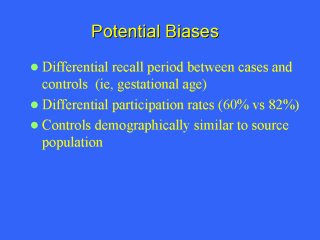| front |1 |2 |3 |4 |5 |6 |7 |8 |9 |10 |11 |12 |13 |14 |15 |16 |17 |18 |19 |20 |21 |22 |23 |24 |25 |26 |27 |28 |29 |30 |31 |32 |33 |34 |review |
 |
- Given
the earlier termination of NTD-affected pregnancies, at the time of interview, control
women were recalling exposures further in the past than case women - Although the case-control difference in recall time was only about 1 month, the shorter recall time for case women may have caused them to remember exposures somewhat more accurately than control women - Combined with the possibility that women with affected pregnancies would recall exposures more carefully, this differential exposure misclassification also would have attenuated observed protective folate effects - If selection bias produced the weak or null folate effect, then control women with higher socioeconomic status (better diets and more vitamin use) must have refused participation more often - However, we know from vital statistics data that control women in the study were remarkably similar to the entire border population |